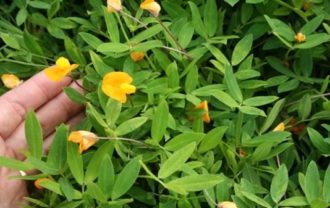GAINESVILLE, Florida – Preliminary research from University of Florida has found that incorporating root-knot nematode-resistant cover crops in a perennial peanut rotation reduces pest numbers in the cash crop and improves yields.
The results may be helpful for producers who choose top-yielding, yet susceptible, peanut cultivars, as well as resistant cultivars that historically carry a lower yield. Root-knot nematodes, soil parasites predominant in areas with hot climates and short winters, can reduce perennial peanut yields and affect plant health by feeding on plant roots.
“By using root-knot nematode-resistant cover crops, it is expected that nematodes are able to identify and infest the cover crop plants, but not be able to develop or reproduce in them, thus reducing the population of root-knot nematodes in the peanut crop,” said Patricio Munoz, assistant professor with University of Florida.
In the SSARE-funded Graduate Student Grant (GS14-134), “Effect of Nematode Suppression Using Cover Crops Resistant to Nematodes on Peanut Production,” Munoz and research assistant Lin Xing conducted field experiments of seven cover crops (common vetch, hairy vetch, white clover, red clover, triticale, wheat and rye) in a peanut production system in central Florida.
Two simultaneous field experiments were carried out for two years on a root-knot nematode-infested field and another field without the presence of the parasite. Each experiment was established with a randomized complete block design with four blocks and within the block, six cover crop treatments with two controls: common vetch with ‘TifGuard’, a root-knot nematode resistant cultivar; and common vetch and ‘Georgia06G’, a popular, high-yielding susceptible cultivar. For the treatments, the fall cover crop plantings were followed by a spring‘Georgia06G’ planting.
There were no significant differences between the two years in the non-infested root-knot nematode field. However, results showed that in the infested field, grasses, such as rye, wheat and triticale significantly reduced nematode populations. In addition, the cover crop grasses had significantly higher yields than legume cover crops.
“All grass cover crop treatments had significantly lower nematode counts than other treatments, followed by the clover treatments,” said Munoz. While nematode populations were still present, the researchers found that the peanut plants appeared to be healthy with no major damage in the peanut kernels.
For producers interested in cover crop yields, the researchers recommend incorporating rye, wheat and triticale into a peanut production system. As expected the resistant peanut cultivar ‘TifGuard’ performed better under nematode pressure than the susceptible peanut cultivar ‘Georgia06G’. Also, when nematodes were present, ‘TifGuard’ decreased the nematode population significantly compared to ‘Georgia06G’ when both followed common vetch. Red and white clover also decreased nematode populations, but they had a negative impact on peanut yields.
Published by the Southern Region of the Sustainable Agriculture Research and Education (SARE) program. Funded by the USDA National Institute of Food and Agriculture (NIFA), Southern SARE operates under cooperative agreements with the University of Georgia, Fort Valley State University, and the Kerr Center for Sustainable Agriculture to offer competitive grants to advance sustainable agriculture in America's Southern region. This material is based upon work that is supported by the National Institute of Food and Agriculture, U.S. Department of Agriculture, through Southern Sustainable Agriculture Research and Education, under sub-award number: GS14-134. USDA is an equal opportunity employer and service provider. Any opinions, findings, conclusions, or recommendations expressed in this publication are those of the author(s) and do not necessarily reflect the view of the U.S. Department of Agriculture.
